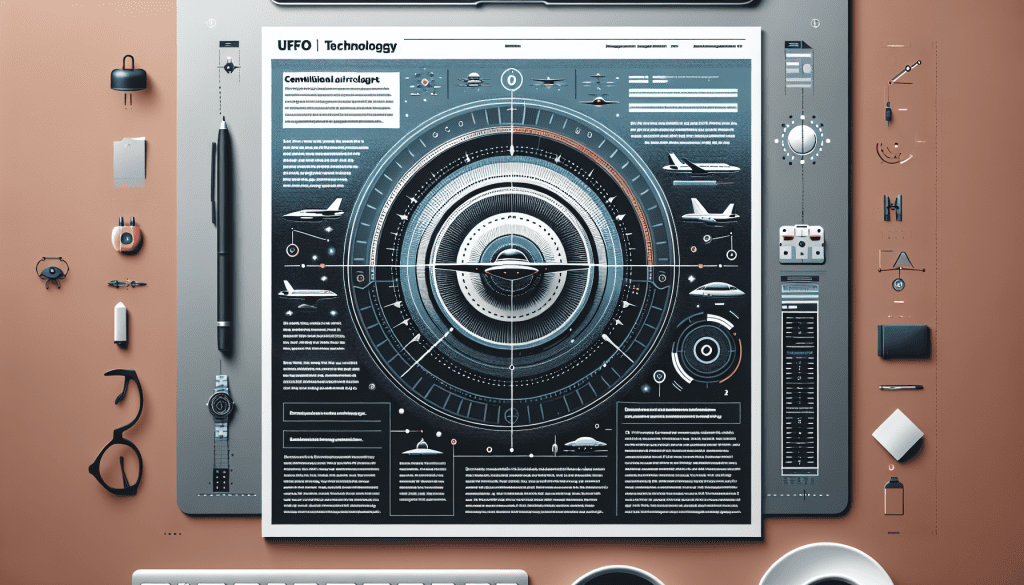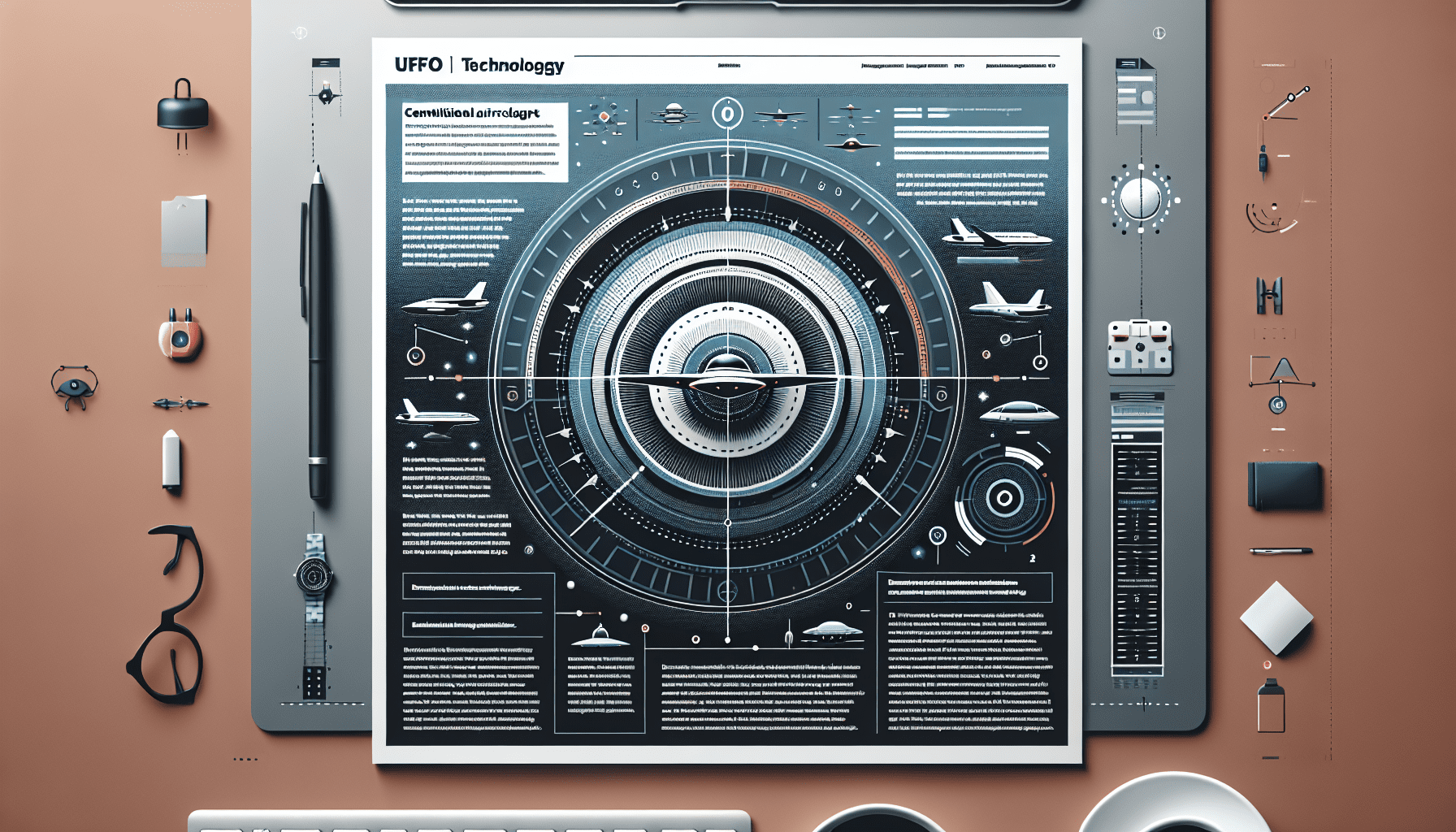So you’re curious about the mysterious sightings in the sky, wondering if those unidentified flying objects could indeed be advanced extraterrestrial technology. Don’t worry, because in this article, you’ll discover some key insights on how to identify UFO technology in the sky. From distinguishing between conventional aircraft and UFOs to recognizing peculiar flight patterns and unconventional characteristics, we’ll equip you with the knowledge you need to become a seasoned UFO observer. Get ready to uncover the secrets of the cosmos and embark on an exciting journey into the unknown!

Overview of UFO Technology
UFO, which stands for Unidentified Flying Object, refers to any object or phenomenon in the sky that cannot be immediately explained or identified. While many people associate UFOs with extraterrestrial life and alien spacecraft, it is important to note that UFO simply means that the object or phenomenon is unknown at the time of observation. UFO technology encompasses the various features, characteristics, and abilities of these unidentified objects, and understanding it requires a holistic approach.
Understanding what UFO stands for
As mentioned earlier, UFO stands for Unidentified Flying Object. It is a broad term that encompasses any object or phenomenon observed in the sky that cannot be readily identified or explained. This includes but is not limited to potential extraterrestrial spacecraft, atmospheric anomalies, secret military aircraft, and natural phenomena. It is important to approach the concept of UFOs with an open mind and a willingness to consider multiple explanations.
Common misconceptions about UFOs
UFOs have long been associated with extraterrestrial life and advanced alien technology. While this is a popular belief, it is essential to approach UFO sightings with skepticism and scientific inquiry. Many sightings that were initially labeled as UFOs have later been identified as conventional aircraft, weather phenomena, or even hoaxes. It is important to differentiate between genuine unidentified objects and those that can be easily explained by known scientific principles.
The technology behind UFO sightings
One of the most intriguing aspects of UFO technology is the advanced flight capabilities that these objects often display. Witnesses commonly report unusual flight characteristics such as sudden changes in direction, rapid accelerations, and hovering abilities. Additionally, UFOs are often observed maneuvering in ways that surpass the capabilities of conventional aircraft, making them stand out in the sky. The propulsion systems, lighting configurations, and absence of traditional noise associated with UFO sightings also contribute to the mystery surrounding their technology.
Identifying UFOs
The importance of observation
Observation is the key to identifying UFOs and understanding their behavior. When attempting to identify a UFO, it is crucial to pay close attention to details and document the sighting as accurately as possible. By observing the object for an extended period, you may gather valuable information related to its flight pattern, speed, shape, and behavior.
Recognizing unusual flight characteristics
Identifying a UFO often involves recognizing flight patterns and characteristics that differ from those of conventional aircraft. UFOs may exhibit erratic movements, sudden changes in speed, or the ability to remain stationary in the sky. These unconventional flight patterns can help distinguish UFOs from known aircraft and natural phenomena.
Taking note of unconventional shapes
UFOs are often reported to have unconventional shapes or structures that deviate from the typical appearance of airplanes or weather balloons. Some common shapes attributed to UFOs include discs, spheres, triangles, and cigar-like objects. Recognizing these unusual shapes can be a vital clue in identifying a UFO and differentiating it from traditional aerial vehicles.
Noticing abnormal speeds and maneuvers
UFOs are frequently reported to travel at astonishing speeds or execute maneuvers that defy the capabilities of conventional aircraft. Witnesses often describe UFOs performing sharp turns or accelerating rapidly without any visible means of propulsion. These abnormal speeds and maneuvers serve as clear indicators that the object in question may be utilizing technology beyond our current understanding.
UFO vs. Conventional Aircraft
Distinguishing UFO sightings from airplanes
Differentiating between UFO sightings and conventional aircraft can be a challenging task for observers. To accurately identify UFOs, it is essential to consider factors such as flight characteristics, shape, lighting, and sound. While airplanes typically follow predictable flight paths and emit recognizable engine sounds, UFOs often exhibit unpredictable behavior and emit no discernible sound.
Understanding differences in flight patterns
Conventional aircraft tend to follow established flight patterns, whether they are in transit or preparing for landing. UFOs, on the other hand, may display flight patterns that defy traditional aerial navigation. These unusual and often erratic flight patterns can help discern UFO sightings from conventional airplanes.
Analyzing lighting and propulsion systems
The lighting configurations of UFOs can differ significantly from those of conventional aircraft. UFOs have been reported to emit various colors and intensities of light, sometimes in patterns that do not correspond to standard aviation lighting. Additionally, the propulsion systems of UFOs are often unknown or unidentifiable, leading to anomalous movement and speeds.
Evaluating the absence of traditional noise
Unlike conventional aircraft, UFOs are often silent or emit sounds that are unlike any known engine noise. Observers have frequently reported the absence of traditional aircraft sounds, such as jet engines or propellers, during UFO sightings. This lack of noise can be a significant indicator when distinguishing a UFO from a conventional aircraft.
Tools for UFO Identification
Using binoculars or telescopes
Binoculars or telescopes can be invaluable tools when attempting to identify UFOs. These optical devices allow for a closer examination of the object, revealing details that may not be visible to the naked eye. By magnifying the object, you can potentially discern specific shapes, lights, or other identifying features that aid in the identification process.
Utilizing night vision equipment
Night vision equipment, such as goggles or cameras, can enhance your ability to observe UFOs during nighttime sightings. These devices amplify existing light sources, making it easier to distinguish objects and their characteristics in low-light conditions. By utilizing night vision equipment, you can improve your chances of gathering detailed information about the UFO in question.
The benefits of infrared cameras
Infrared (IR) cameras can detect and capture thermal radiation, which is emitted by objects due to their temperature. By using an IR camera, observers can potentially identify heat signatures associated with UFOs that may be invisible to the naked eye or other camera systems. These unique heat signatures can provide essential evidence in identifying and analyzing UFO sightings.
Employing radar and other detection technology
Sophisticated radar systems and other detection technologies can aid in identifying UFOs by providing additional data points and measurements. Radar systems can track the movement and trajectory of UFOs, giving valuable insights into their flight patterns and speeds. Combining radar data with visual observations can provide a more comprehensive understanding of UFO behavior.
Collecting Evidence
Importance of capturing photographs or videos
When encountering a UFO, capturing photographs or videos is crucial for documenting the sighting and preserving evidence. High-quality visual evidence can help corroborate eyewitness testimonies and provide detailed information for further analysis. Photographs or videos should be taken from various angles, capturing the object’s shape, movement, and any distinguishable features.
Documenting date, time, and location
Accurate documentation of the date, time, and location of a UFO sighting is essential for establishing the credibility of the event. This information allows researchers and investigators to compare and cross-reference sightings, potentially identifying patterns or correlations. Be sure to note any relevant environmental conditions, such as weather or visibility, that may impact the sighting.
Gathering multiple eyewitness testimonies
Collecting multiple eyewitness testimonies adds credibility and diversity of perspectives to a UFO sighting report. Encourage other witnesses to come forward and share their observations and experiences. Corroborating testimonies can strengthen the case and provide a more comprehensive understanding of the UFO event.
Submitting reports to reliable UFO organizations
To ensure that your UFO sighting is properly documented and analyzed, consider submitting a report to reliable UFO organizations or research institutions. These organizations have the expertise and resources to evaluate and investigate sightings thoroughly. Submitting your report to credible sources increases the chances of it being included in comprehensive databases and potentially contributing to advancements in UFO research.
Analyzing UFO Data
Reviewing recorded flight paths and behavior
Analyzing recorded flight paths and behaviors of UFO sightings can reveal valuable insights into their capabilities and characteristics. By reviewing documented cases, researchers can identify patterns, commonalities, or deviations from known flight patterns. This analysis helps to categorize and understand the behavior of UFOs more effectively.
Comparing sightings with previous documented cases
Comparing current UFO sightings with previously documented cases can aid in understanding the nature of unidentified objects. By identifying similarities or shared attributes, researchers can make connections between different sightings and potentially uncover recurring patterns or behaviors. This comparative analysis contributes to building a more comprehensive understanding of UFO technology.
Identifying potential technological advancements
Studying UFO data can provide important clues about potential technological advancements that surpass our current understanding. By identifying recurring characteristics or features in UFO sightings, researchers can speculate on possible advancements in propulsion systems, flight capabilities, energy sources, or materials. This analysis lays the groundwork for future technological exploration and scientific advancements.
Categorizing UFO sightings based on characteristics
Analyzing UFO data allows for the categorization of sightings based on shared characteristics or attributes. By identifying commonalities, such as shape, behavior, or effects on the surrounding environment, UFO sightings can be grouped into distinct categories. This categorization facilitates the organization and classification of UFO sightings, making it easier to study and understand their various characteristics.
Debunking Explanations
Exploring natural phenomenon explanations
Many UFO sightings can be explained by natural phenomena such as meteors, atmospheric anomalies, or celestial objects. When encountering a UFO, it is important to consider these natural explanations before jumping to extraterrestrial conclusions. Researching and understanding natural phenomena helps debunk false assumptions and fosters a more critical and scientific approach to UFO sightings.
Considering misidentifications and hoaxes
Misidentifications of known objects or hoaxes can often give the appearance of UFO sightings. Weather balloons, remote-controlled drones, or even cleverly manipulated video footage can create the illusion of unidentified objects in the sky. It is vital to consider these possibilities and thoroughly investigate before concluding that an observed object is indeed a UFO.
Examining human-made technology possibilities
UFOs are not solely limited to extraterrestrial origin; they can also be the result of classified military or experimental technology. Governments around the world have been known to conduct secret tests and projects that involve unconventional aerial platforms. Understanding the capabilities and characteristics of human-made technology is essential in ruling out conventional explanations for UFO sightings.
Addressing potential government secrecy
Government secrecy and classified programs can contribute to the mystery surrounding UFO sightings. It is plausible that certain UFO sightings may be the result of government experiments or advanced military technology. This raises questions about the extent of government knowledge and involvement in UFO phenomena. Considering the possibility of government secrecy provides a more nuanced perspective on UFO sightings.
Professional UFO Research
Learning from dedicated UFO researchers
Professional UFO research involves studying the work of dedicated researchers who have devoted their time and expertise to the subject. By reading books, articles, and research papers by renowned UFO researchers, you can gain valuable insights into the methodologies, theories, and discoveries in the field. Learning from professionals provides a solid foundation for further study and exploration.
Studying scientific investigations and findings
Scientific investigations into UFO phenomena can shed light on the subject from a more objective and evidence-based perspective. Research studies, experiments, and analyses conducted by scientists can offer valuable contributions to the understanding of UFO technology. Studying scientific investigations and findings helps bridge the gap between mainstream science and the study of unidentified objects.
Exploring credible UFO sighting databases
Credible UFO sighting databases, maintained by reputable organizations or research institutions, provide a wealth of resources for in-depth analysis and exploration. These databases compile and categorize reported UFO sightings, making it easier to study patterns and gather statistical data. Exploring these databases allows for a comprehensive overview of UFO sightings and their characteristics.
Attending conferences and lectures on the topic
Conferences and lectures dedicated to the study of UFOs provide opportunities to learn from experts, engage in discussions, and share insights with like-minded individuals. These events offer a platform for presenting new research, discussing theories, and promoting scientific inquiry into UFO phenomena. Attending conferences and lectures fosters a sense of community and facilitates the exchange of knowledge among UFO enthusiasts.
Reporting UFO Sightings
Contacting local authorities or UFO organizations
If you have witnessed a UFO sighting, it is important to report the event to local authorities or dedicated UFO organizations. Local law enforcement or government agencies may have official procedures for documenting and investigating such incidents. Additionally, UFO organizations specialize in collecting and analyzing UFO sighting reports, ensuring that the information is recorded and evaluated by experts in the field.
Submitting reports to reliable UFO sighting databases
To contribute to the collective knowledge and understanding of UFOs, consider submitting your sighting report to reliable UFO sighting databases. These databases serve as central repositories for UFO data and are accessible to researchers, investigators, and the general public. Submitting your report to these databases ensures that your observations are available for analysis and inclusion in comprehensive studies.
The importance of detailed and accurate testimonials
When reporting a UFO sighting, providing a detailed and accurate testimonial is crucial. Include specific information such as the date, time, and location of the sighting. Describe the object’s appearance, movement, and any other relevant details. The more comprehensive and accurate the testimony, the more valuable it is for future research and analysis.
The role of citizen science in advancing knowledge
Reporting UFO sightings and contributing to citizen science initiatives can significantly advance our understanding of UFO technology. Citizen science encourages the public to actively participate in scientific research by reporting observations and providing data for analysis. By engaging in citizen science, individuals can contribute to the collective knowledge and collaborative efforts in studying UFOs.
Further Study and Exploration
Learning about related fields of study
To gain a comprehensive understanding of UFOs and their technology, it is beneficial to explore related fields of study. Areas such as astronomy, astrophysics, aerospace engineering, and psychology can provide valuable insights into the scientific, technological, and psychological aspects of UFO phenomena. Learning from these disciplines enriches the study of UFOs and facilitates a multidisciplinary approach to understanding unknown aerial objects.
Engaging in amateur UFO research
Amateur UFO research allows individuals to actively investigate and study unidentified aerial phenomena. By conducting personal investigations, collecting data, and applying scientific methodologies, amateurs can contribute to the body of knowledge surrounding UFO technology. Engaging in amateur research fosters critical thinking, promotes scientific inquiry, and encourages collaboration with other enthusiasts.
Joining online communities and forums
Online communities and forums dedicated to UFO research provide platforms for discussion, knowledge sharing, and collaboration. Joining these communities allows you to connect with like-minded individuals, exchange ideas, and learn from a diverse range of perspectives. Online communities provide opportunities to stay updated on the latest research, share personal experiences, and engage in meaningful conversations about UFO technology.
Contributing to the collective understanding of UFOs
Contributing to the collective understanding of UFOs can be achieved by actively engaging in research, sharing experiences, and proposing alternative explanations. By continuously questioning, investigating, and documenting UFO sightings, individuals can contribute to the ongoing dialogue surrounding UFO technology. Valuing open-mindedness, scientific rigor, and collaboration is essential in advancing our understanding of this fascinating phenomenon.
In conclusion, identifying UFO technology in the sky requires careful observation, analysis of flight characteristics, and consideration of various possibilities. It is crucial to approach UFO sightings with scientific skepticism and explore multiple explanations, including natural phenomena, misidentifications, human-made technology, and potential government secrecy. By utilizing tools, collecting evidence, and analyzing data, we can contribute to the study of UFOs, engage in professional research, and participate in citizen science initiatives. Further study and exploration of related fields, joining online communities, and actively participating in research can all contribute to the collective understanding of UFO technology and the advancement of knowledge. Remember to approach the subject with an open mind, contributing to the ongoing quest for answers about the mysteries that often take place in our skies.

